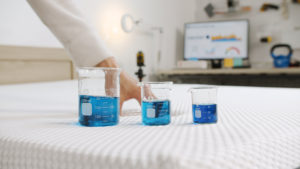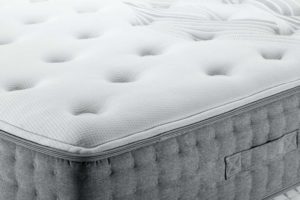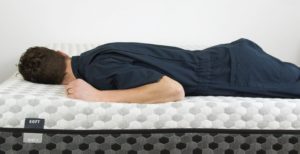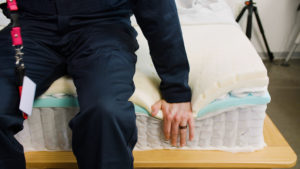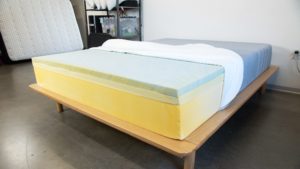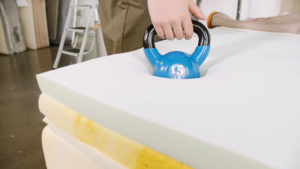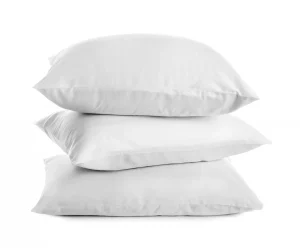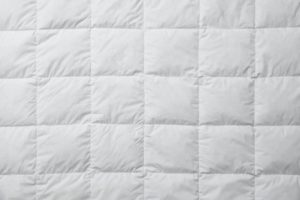Mattress Topper Research Methodology
A mattress topper is a layer of cushioning material that rests on top of your mattress, either tucked beneath your fitted sheet or secured with corner straps. You should consider a topper if your mattress has become worn or misshapen with use, but you aren’t ready to invest in a new bed. A topper may also be useful if your mattress feels too firm or your firmness preferences have changed over time.
Our expert team uses a comprehensive methodology for testing mattress toppers. We evaluate each topper across the same set of performance criteria, and also take factors like body weight and sleeper position into account. This strict set of guidelines allow us to make mattress topper recommendations for different types of sleepers. We’ll cover our in-house topper testing process in detail and explain why all of our performance criteria are important for our hands-on evaluations.
Why You Should Trust Us
At Sleep Foundation, we pride ourselves on authoritative ratings and recommendations for a wide range of products. Each member of our testing team holds years of experience researching and evaluating sleep products. We also value diversity of opinion. This is why our team consists of side, back, stomach, and combination sleepers across various weight groups.
Our ratings and reviews are based on firsthand testing. We only recommend products that have undergone our entire testing process. With each new round of tests, our team also revisits our current guides and — if needed — updates our top picks to reflect the most recent evaluations.
Our Mattress Topper Research and Testing
All mattress topper tests are conducted in our sleep lab located inside Sleep Doctor’s Seattle office. Each topper undergoes several stages of testing, during which we evaluate different performance areas. Many of these tests involve us lying or moving on the topper. We also incorporate technology into these tests, such as thermal sensors to track heat retention, body-mapping tools that pinpoint areas of pressure buildup, and a VOC meter to measure off-gassing levels.
We have controls in place to ensure complete objectivity during these tests. Over the course of our tests, each topper is placed on a flat surface, a medium soft (4) mattress, a medium (5) mattress, a medium firm (6) mattress, and a firm (7) mattress. We test using so many different surfaces to evaluate how the topper impacts the feel of different types of mattresses.
How Do You Know a Mattress Topper Is Right for You?
There are many good reasons to invest in a mattress topper. If your mattress is relatively old, you may notice impressions or indentations in the surface when you lie down. A topper can remedy these signs of wear and tear to a degree. You may also benefit from a topper if your firmness preferences have changed over time, leaving your mattress feeling too firm or too soft. You can also buy a topper if you frequently host overnight guests in a spare bedroom and want them to be as comfortable as possible.
As with a mattress, there are a few considerations to make when choosing a mattress topper. A softer topper may be comfortable if you weigh less than 130 pounds, but people who weigh more often need the support of a medium (5), medium firm (6), or firm (7) topper. Your sleep position is another important factor. If you sleep on your side, you’re more vulnerable to pressure buildup in the shoulders and hips, and you’ll likely need more cushioning than a back or stomach sleeper. If you’re happy with the feel of your mattress but your sleep partner is not — or vice versa — then you could consider a topper that only covers one half of the mattress.
One last thing to keep in mind is that a topper is a temporary fix for an old mattress, not a permanent solution. If your mattress is so worn that it cannot provide adequate support, then a topper won’t do much to make your sleep surface feel more comfortable. A topper may buy you some extra time, but ultimately you’ll need to invest in a new mattress in order to sleep comfortably and wake up without pain.
Mattress Toppers, Mattresses, and Sleeping Position
A topper and mattress interact with each other based on how firm both surfaces feel. For example, if you place a soft topper on a firm mattress, you’ll likely notice more cushioning that creates a significant change to how your sleep surface feels. This change may be less noticeable if you place a soft topper on a soft mattress. Alternatively, you can use a firm topper to change the feel of a soft mattress.
This is why we recommend experimenting with different toppers. There may be some trial and error involved before you nail down the right topper firmness for your mattress. Your sleep position further complicates this dynamic. If you sleep on your side, you’ll probably need extra cushioning to reduce pressure in the shoulders and hips. Back and stomach sleepers are less prone to pressure in these areas, but they need less cushioning and more support to feel properly reinforced around the midsection.
Mattress Topper Firmness and Support
Our team assigns firmness levels to toppers much like we do for mattresses. We follow a 10-point scale, with 1 as the softest and 10 as the firmest. Most toppers we’ve tested fall between 3 and 8, or “soft” and “firm.” The topper’s construction and thickness are the two factors that most affect how soft or firm a topper feels.
For any given sleeper, the right combination of cushioning and support is key to a good night’s rest. If you weigh less than 130 pounds, you won’t need as much support from your sleep surface and a softer feel probably feels most comfortable. The opposite is true for people who weigh more than 230 pounds, who typically need a firmer feel for their entire body to feel properly supported. People who weigh 130 to 230 pounds tend to prefer medium (5) or medium firm (6) feels.
A topper should work with your mattress to cushion your body, push back against your weight, and keep your spine aligned. If your mattress is too soft or too firm for your body, aches and pains are more likely to occur.
Mattress Topper Feel
The goal of a topper is to make your sleep surface more comfortable. A topper’s feel largely depends on its materials. Foam toppers are adaptive for close, even contouring. Latex toppers also conform to the body, but in a gentler, less noticeable way, and this naturally responsive material often produces a light bounce when you get in and out of bed. If you opt for a feather topper, expect a plush feel that cushions without adapting to your figure.
A topper’s thickness can also affect its feel. The general rule of thumb is that the thicker a topper is, the more it changes how your sleep surface feels. A 4-inch latex topper creates more bounce than a 2-inch model. Likewise, a thicker foam topper contours more closely than a thinner model.
Mattress Topper Construction
Toppers are constructed from a wide range of materials. The most common topper materials include memory foam, convoluted (or “egg crate”) polyfoam, latex, down and feathers, down alternative fibers, and wool. Toppers may feature layered designs that integrate more than one of these materials, but this type of construction is fairly rare.
While some toppers do not come with a cover, most are encased in some type of machine-washable fabric that allows you to keep your sleep surface clean and hygienic. Common topper cover materials include cotton, polyester, and rayon derived from bamboo. Many feature elastic corner straps to secure the topper to your sleep surface. We recommend toppers with corner straps for people who frequently change sleep positions or toss and turn.
As we’ve seen with our hands-on tests, each type of topper is characterized by certain strengths and weaknesses. For example, memory foam and polyfoam toppers tend to excel at contouring, pressure relief, and motion isolation, but they also retain excessive heat and produce high amounts of off-gassing odor. Latex toppers typically offer better cooling and lower odor potential, but they don’t alleviate as much pressure and often feel bouncy to a disruptive degree.
Construction often affects price, as well. Memory foam, latex, and wool toppers tend to cost more than their polyfoam, down and feather, and down alternative counterparts. Sometimes the price difference can amount to hundreds of dollars. Thickness is another consideration. Certain types of toppers, such as foam and latex, are widely available in profiles between 1 and 4 inches. This range is a bit more limited for down and feather and down alternative toppers, which tend to be on the thinner side.
We recommend nailing down two or three topper qualities that matter most to you, as well as a realistic shopping budget. Setting up guidelines will help ensure you’ll be satisfied with the topper you ultimately choose.
When Should I Use a Mattress Topper?
A topper is designed to improve the comfort level of your mattress by changing how the sleep surface feels. You should consider a mattress topper if one or more of the following scenarios applies:
- Your mattress has light wear and tear that makes the surface feel less uniform.
- Your mattress feels either too soft or too firm.
- You’d like to improve your bed’s temperature control or pressure relief.
- You and your sleep partner have different firmness preferences.
- You are furnishing a guest room or vacation rental.
If your mattress is near the end of its lifespan and its uneven surface is causing you to feel pain or pressure points, we do not recommend using a topper. Instead, you should consider buying a new mattress altogether. Toppers can be effective for lightly worn mattresses, but extra cushioning only goes so far if your sleep surface has deep indentations or impressions.
Our Performance Criteria
Next, we’ll dive into the performance criteria we use during our hands-on topper tests. All of the topics below represent a different stage of these tests.
Multiple testers across different body weights and sleep positions participate in each stage. After the stage has concluded, the testers assign a score for that performance category based on our five-point rating scale:
- 1: Poor
- 2: Fair
- 3: Good
- 4: Very Good
- 5: Excellent
The scores are averaged together to produce a final score for that given category. To keep scoring simple, we round up if the score has a decimal point followed by 5 or higher. For instance, a final score of 3.5 would be considered 4, or very good, while a 3.4 rounds down to 3, or good.
Our testing includes the following stages:
Durability
Durability is one of the few performance areas for which we don’t directly test the topper. Instead, we base this rating on the quality of design, firmness, profile, and average lifespan of the topper’s core materials.
In our experience, the longest-lasting toppers have firm feels and thin profiles. Latex and dense foam are two of the most durable topper materials because they resist indentations and other types of wear and tear. Conversely, thicker and softer toppers tend to lose their shape more quickly and may develop impressions after limited use.
This may create a trade-off situation if you’re looking for a topper to make your sleep surface feel significantly softer — a common reason for purchasing toppers. A 3-inch or 4-inch topper with a medium (5) or medium firm (6) design might be a good compromise. You’ll get extra cushioning and a major comfort adjustment, but the topper should hold up until you’re ready to purchase a new mattress.
Firmness
As we mentioned earlier, our team uses the same 10-point firmness scale for mattresses and mattress toppers. Our testers take turns lying on the topper to determine which firmness level should be assigned. We pinpoint firmness using several surfaces, including flat wood and mattresses with medium soft (4), medium (5), medium firm (6), and firm (7) feels.
Sleeper Weight
Our testing team strives to assign performance ratings inclusive of all sleepers’ needs. To achieve this, we rely on feedback from people with different body types. For each topper test, we elicit participation from at least two testers in each of the following weight categories:
- Less than 130 pounds
- 130 to 230 pounds
- More than 230 pounds
In most cases, topper ratings vary considerably between the weight groups. Softer toppers tend to receive the most favorable scores from testers weighing less than 130 pounds, while firmer toppers often earn high marks from testers weighing more than 230 pounds. We’ve found toppers with mid-range feels of 4 to 6 typically perform best across all three weight groups.
Sleeping Position
As with different weight groups, the accuracy and objectivity of our tests hinge on feedback from people who primarily use different sleep positions. Our testing incorporates participation from side, back, and stomach sleepers. We also include combination sleepers who use two or more of these positions on a regular basis. Each tester takes turns lying on the topper with different underlying surfaces.
Our tests have shown side sleepers generally prefer softer surfaces. Extra cushioning can help align the spine, and reduce pressure buildup in the weight-bearing shoulder and hip that often occurs when using the side position.
Back sleepers exert even pressure on both shoulders and hips, so they don’t need as much cushioning as side sleepers, but extra support around the midsection helps ensure their heaviest areas won’t sink too much — a common source of shoulder and lower back pain. A medium (5) to medium firm (6) topper should satisfy most back sleepers.
Stomach sleepers are similar to back sleepers because extra reinforcement around the torso and hips can help limit sinkage and prevent unwanted pain. However, they tend to sink more deeply because of the extra weight people carry in their stomach. As we’ve seen during our tests, stomach sleepers typically prefer firm (7) toppers.
Support
Proper support is crucial for comfortable sleep. A supportive topper promotes even spinal alignment, maintains an even shape when weight is applied, resists sinking when you move across it, and holds up well over time with minimal sagging and indentations.
We gauge a topper’s support with the help of testers across all body weight and sleep position groups. Everyone has different support needs based on these two factors. Since firmer toppers are usually more supportive, these models tend to be most popular among our back and stomach sleepers. Our side sleepers, on the other hand, often receive adequate support from soft to medium toppers.
We rate support using objective and subjective means. Body-mapping software allows us to view areas of pressure buildup. Pressure occurs when a topper does not provide enough support for areas like the shoulders, back, and hips, leading to uneven alignment. Each of our testers also provides their own subjective feedback about how supportive the topper felt, and whether or not they experienced uncomfortable sinkage.
Motion Isolation
Motion isolation refers to a topper’s ability to absorb movement and prevent transfer in other areas of the sleep surface. This performance category is mostly relevant to co-sleepers. If a mattress does not isolate motion well, then you and your partner may experience sleep disruptions when the other person changes positions, tosses and turns, or gets in and out of bed.
We employ a handful of individual tests to evaluate toppers for motion isolation. First, we ask two testers to lie side by side. One person remains still while the other rolls over, changes sleep positions, gets out of bed, and sits at the edge of the mattress to mimic tying shoes. Next, one sleeper remains on the mattress while the other drops a kettlebell next to them from heights of 3 and 5 feet. Lastly, we place a container of water on the mattress and a tester recreates the same natural movements. If the topper provides decent motion isolation, the water should remain upright and not spill. During these tests, we use SensorTag technology, which records ripples of movement much like a seismograph.
The caveat here is that your mattress plays a much larger role in isolating motion than a topper will. Even if your topper measures 4 inches or more and is made of a material that absorbs movement well, this may have little to no effect if your mattress is exceptionally bouncy. That said, a topper can improve the motion isolation of your sleep surface if the mattress is not overly responsive. We’ve found the best topper materials for isolating motion are memory foam and polyfoam.
Conforming
Most toppers conform to some extent. We rate a topper for conforming based on how evenly the surface adapts to your body’s unique shape and distributes your weight.
Our conforming ratings are largely subjective, with each tester giving feedback about how evenly the topper contours. Pressure-mapping tools can also be useful for this testing stage because we’ve found toppers that conform evenly tend to reduce pressure better than those that merely cushion the body.
Temperature Control
Some toppers absorb heat and sleep somewhat warm, while others promote a generous amount of airflow and feel cooler. The ideal topper should be temperature neutral any time of year, providing enough cooling and breathability without sacrificing the warmth you need on chilly nights.
During our temperature control tests, we take measures to maintain a consistent room temperature in our lab and monitor a wall thermometer for any unexpected shifts. For our first test, we heat a water bottle to 98.6 degrees to mimic human body temperature and place it on the topper for 15 minutes. After removing the bottle, we measure the topper’s surface temperature to gauge how much heat the core material has retained. For subjective testing, our testers take turns lying on the topper. Each person provides feedback about how much airflow they felt, and whether the sleep surface felt uncomfortably warm or cool.
One thing to keep in mind is that a topper’s core and cover materials play a role in temperature control. A breathable core encased in a fabric that hinders airflow might still sleep too warm. Likewise, a cooling cover can limit heat retention for a core that otherwise traps heat. We’ve found that ventilated latex, down alternative, and wool toppers provide the best temperature control. Most toam toppers contour closely, which restricts airflow and often leads to excessive warmth.
Sex
Like durability, sex is a performance category we don’t test firsthand. Instead, we aggregate scores from other categories that affect whether a topper enhances or hinders sexual activities.
Sleeper surveys we’ve conducted indicate most couples prefer responsive surfaces for sex, as bounciness prevents you from sinking too much. Temperature control is another consideration, since a surface that traps heat could make amorous activities less enjoyable.
Many toppers aren’t very suitable for sex because they are plush and adaptive, rather than firm and responsive. You may find a topper is necessary to sleep comfortably on your mattress, but still prefer removing it for sex.
Off-Gassing and Odor Potential
After unboxing a new topper, you may notice a chemical odor. This is known as off-gassing. Foams and other synthetic materials off-gas because they contain volatile organic compounds (VOCs), which become trapped in the wrapping materials used to ship toppers and other sleep products. As you remove the wrapping, these particles escape. Many liken the smell of VOCs to plastic. VOCs are relatively harmless, but a topper with heavy off-gassing can be hard to stomach at first.
Other topper materials may not contain VOCs, but still emit noticeable smells. Latex has a rubber-like odor, which comes from rubber trees used to produce the latex. Many describe wool and down and feather toppers as having an earthy aroma, which may be due to their animal sources.
Our odor potential tests are fairly simple. After unboxing the topper, we’ll use a VOC meter to measure the concentration of particles in the air. We’ll repeat this process several times over the next two days. In addition to the meter, our testers provide their own subjective feedback about how strongly the topper smells. We also consider whether a topper’s materials will produce new odors down the road if it is not properly cared for, and whether the topper and its cover can be cleaned. These factors help us determine future odor potential.
Off-gassing is rarely a long-term issue. Most toppers completely shed their odor within three or four days, and many stop smelling within hours of unboxing. If your new topper has a strong scent, we recommend placing it in a well-ventilated room for a day or two before using it for the first time.



